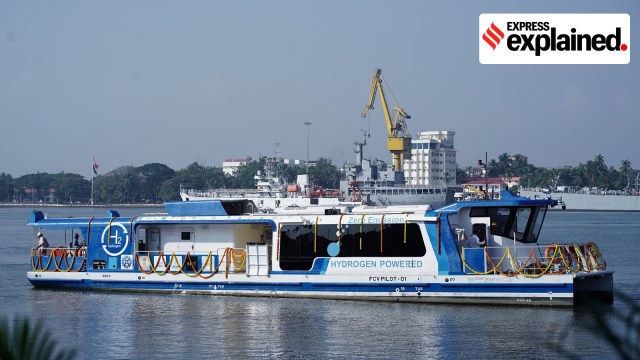PM Modi launches hydrogen-powered ferry: features, significance
Built by the Cochin Shipyard Limited, the ferry will be deployed for service in Varanasi. Here's why India developing the environment-friendly vessel is significant.
 Built at a cost of Rs 18 crore, the ferry will be handed over to the Inland Waterways Authority of India by the CSL after rigorous trials.
Built at a cost of Rs 18 crore, the ferry will be handed over to the Inland Waterways Authority of India by the CSL after rigorous trials. Prime Minister Narendra Modi Wednesday virtually launched India’s first indigenously developed hydrogen fuel cell ferry. The vessel, manufactured by Cochin Shipyard Limited (CSL), will be deployed for service at Varanasi in Uttar Pradesh.
Built at a cost of Rs 18 crore, the ferry will be handed over to the Inland Waterways Authority of India by the CSL after rigorous trials. The Ministry of Ports, Shipping and Waterways met 75 per cent of the project cost.
What are the special features of the vessel?
The Hydrogen fuel cell vessel is a 24-meter-long catamaran, which can carry 50 people in its air-conditioned passenger area. The accommodation area has been constructed with high-quality fiberglass reinforced plastic, similar to metro train coaches.
Hydrogen fuel cell vessels do not use conventional batteries as the primary storage house of electrical energy. The vessels run on hydrogen fuel, which is stored in cylinders. This boat has five hydrogen cylinders that can carry 40kg of hydrogen and support eight hours of operations. The vessel is also fitted with a 3-kW solar panel.
The hydrogen fuel cell-powered vessel has zero emission, zero noise and is energy-efficient, which makes it more environment-friendly. Since there are no moving parts, the ferry requires less maintenance than combustion vessels.
How do hydrogen fuel cells work?
A hydrogen fuel cell generates electricity by utilising the chemical energy contained in hydrogen. It releases only pure water, not discharging pollutants. Hydrogen is loaded into cells. The energy within the hydrogen is converted into electricity and heat, which is then used to power the vessel’s propulsion mechanism. In the fuel cell, the hydrogen reacts with the oxygen in the air to produce electricity. Unlike batteries, hydrogen fuel cells do not require recharging. Provided uninterrupted supply of fuel and oxygen, these cells would work continuously.
What type of cells have been used in the vessel?
This vessel uses a 50-kW PEM (proton-exchange membrane) fuel cell, with Lithium-Ion Phosphate batteries. The advantage is that the cells can quickly change their output depending upon the power demand. PEM fuel cells are popular in automotive applications because they operate at a lower temperature, and are lighter and more compact.
How was it developed?
India has now indigenously developed hydrogen fuel cells and their related systems.
The vessel has been built completely by the CSL, which also developed the vessel automation system and power management system. The hydrogen fuel cell system was developed by KPIT Technologies, Pune, in collaboration with the Council of Scientific and Industrial Research Labs, under the Union Ministry of Science and Technology.
While hydrogen fuel cell technology has been under development for maritime applications, only a few countries globally have done demonstration projects. This ferry, thus, has given India an early mover advantage to tap the potential of hydrogen as an emerging green fuel in the marine sector.
The ‘Harit Nauka’(green boat) initiative of the Ministry of Ports, Shipping and Waterways envisages a green transition of inland vessels. In line with this, the ferry can be replicated in other parts of the country for urban mobility. It is also a boost to the National Green Hydrogen Mission.
What is the Harit Nauka initiative?
In January 2024, the shipping ministry unveiled the Harit Nauka guidelines for inland vessels. As per the guidelines, all states have to make efforts to use green fuels for 50 per cent of inland waterways-based passenger fleets in the next one decade, and 100 per cent by 2045. This is to reduce greenhouse gas emissions as per the Maritime Amrit Kaal Vision 2047.
Globally, the shipping industry is increasingly transitioning to green fuels due to environmental regulations, sustainability goals, and advancements in green fuel technologies. Hydrogen and its derivatives are gaining attention for promising zero-emission fuels for the industry.
- 01
- 02
- 03
- 04
- 05






































